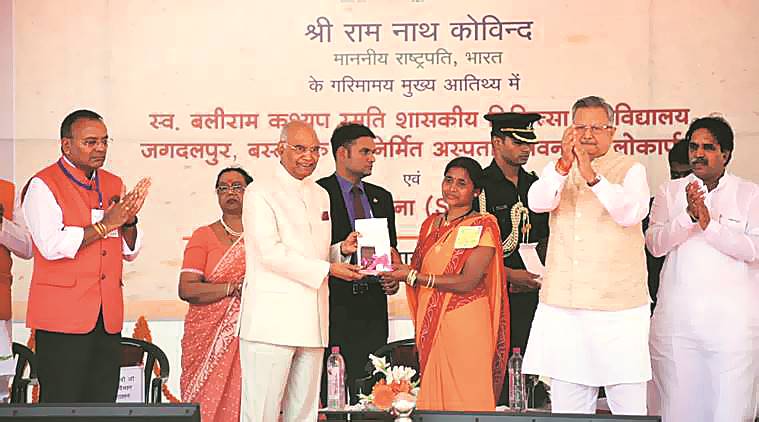 President Ram Nath Kovind and CM Raman Singh at an event to distribute free smartphones, in Jagdalpur. (Express File)
President Ram Nath Kovind and CM Raman Singh at an event to distribute free smartphones, in Jagdalpur. (Express File)
The Raman Singh-led BJP government’s pre-poll scheme offering free smartphones may not make a dent in districts with the lowest mobile penetration in Chhattisgarh. While fewer people than the state average of 29 per cent have mobile phones in these 16 districts, only a little over 10 lakh of the 28.8 lakh phones (roughly a third) have been distributed here under the first phase of the Sanchar Kranti Yojana, as per data from the Chhattisgarh Infotech Promotion Society (CHIPS), the agency administering the smart phone scheme.
The 16 districts (Mungeli, Mahasamund, Kanker, Surajpur, Koriya, Korba, Sirguja, Balrampur, Jashpur, Bastar, Gariyaband, Kondagaon, Dantewada, Narayanpur, Sukma and Bijapur, in descending order of mobile penetration) account for 38 of the 90 Assembly seats in the state, and nearly 40 per cent of its total electorate. The BJP had won 19 of the 38 seats in the 2013 Assembly polls.
Given that these districts have a lower mobile penetration than the state average, there would have been a larger demand for smartphones here. As of 2011, roughly 40 per cent of Chhattisgarh was outside phone coverage area. CHIPS CEO Alex Menon calls the Chhattisgarh freebie project, at a total outlay of Rs 1,467.90 crore, “the world’s largest mobile distribution scheme and mobile network expansion scheme”.
Under the first phase, till September 28, 86 lakh phones with free six-month data plan and 100 free call minutes every month for six months had been distributed. Around 5 per cent (1.6 lakh) of the phones remain undelivered because the beneficiaries did not pick them up from distribution camps.
Two of the districts with the lowest mobile penetration, Sukma and Bijapur, fall in the Naxal-hit Bastar region. Together, Bastar’s 12 seats have received 2 lakh or 7 per cent of the delivered phones so far. In the 2013 elections, the region accounted for over 11 per cent of the total voters. The BJP had won only four of the 12 seats, with the Congress getting the remaining — a reversal from the 2008 Assembly polls, when the BJP had got 11 of the 12 seats.
In Sukma and Bijapur, phone distribution is also stuck because the mobile network itself is not fully laid out in the area, said a CHIPS official. The two-phased Sanchar Kranti Yojana or SKY, launched in July end, also aims to improve network connectivity in Chhattisgarh. On SKY list are 40.8 lakh rural household beneficiaries, 5.67 lakh urban ones, and 4.2 lakh college students. The list of beneficiaries was drawn up on the basis of the 2011 Socio-Economic Caste Census for rural beneficiaries and the 2007 Below the Poverty Line List for urban beneficiaries. All college students in the state were eligible, said the CHIPS official.
“It is quite an extensive project for a small state like Chhattisgarh,” said Menon. “The reality is Chhattisgarh is struggling with connectivity and mobile penetration. We were discussing how to do something drastic. The scheme has been a data-driven governance scheme from day one.” CHIPS data reveals that as of 2017, a little over 7,000 villages in Chhattisgarh were not covered by phones, compared to almost 10,000 that were completely covered and 2,500 that were semi-covered.
It collected telecom operator data regarding tower location and geographic network coverage to determine that the state would need roughly 1,589 towers to cover the dark villages with more than 1,000 population. This would bring the mobile tower count of Chhattisgarh to almost 11,000, leaving 22 per cent of villages unconnected.
Menon said they also found that with an assumed Rs 60 average revenue per user, for every eight viable mobile towers, one unviable mobile tower could be supported, to break even in the next two years or less. Jio and Micromax had won the tender process for the phone scheme in early April. Consequently, 900 government plots were given to Jio for free to erect more than a thousand towers in six months. Following consultations with gram sabha, phones were shipped. The team also trained people to be e-KYC agents and distributors.